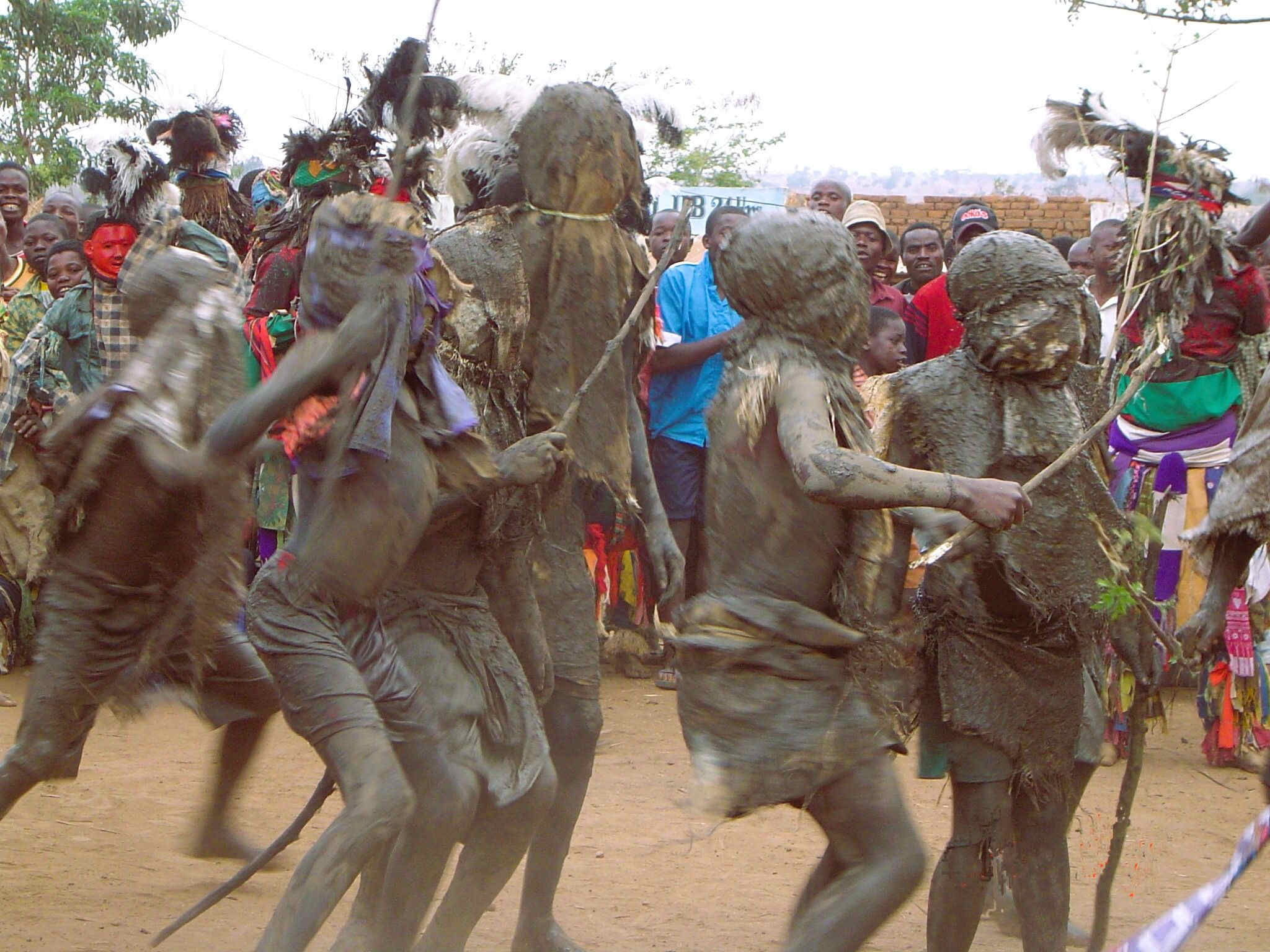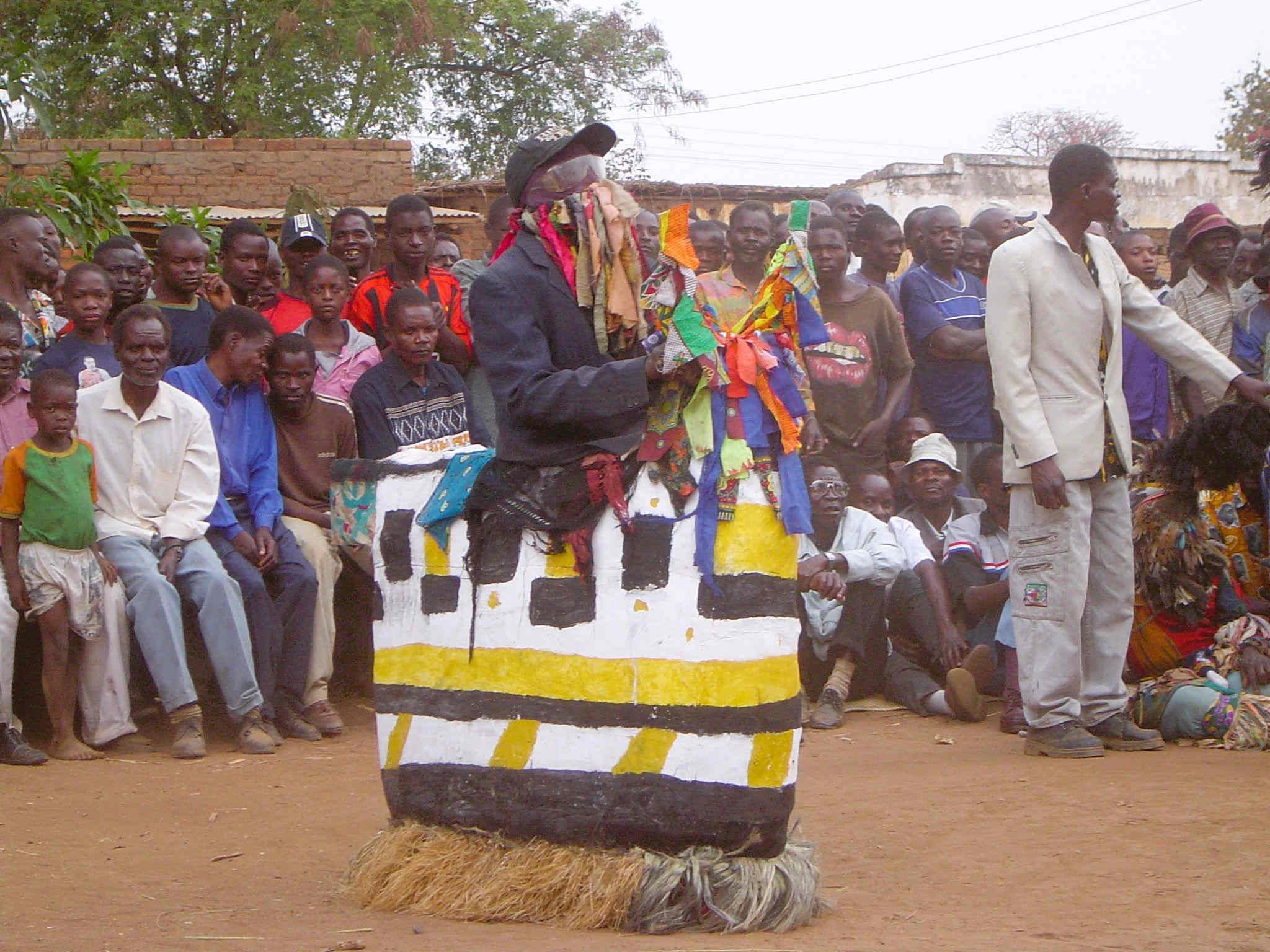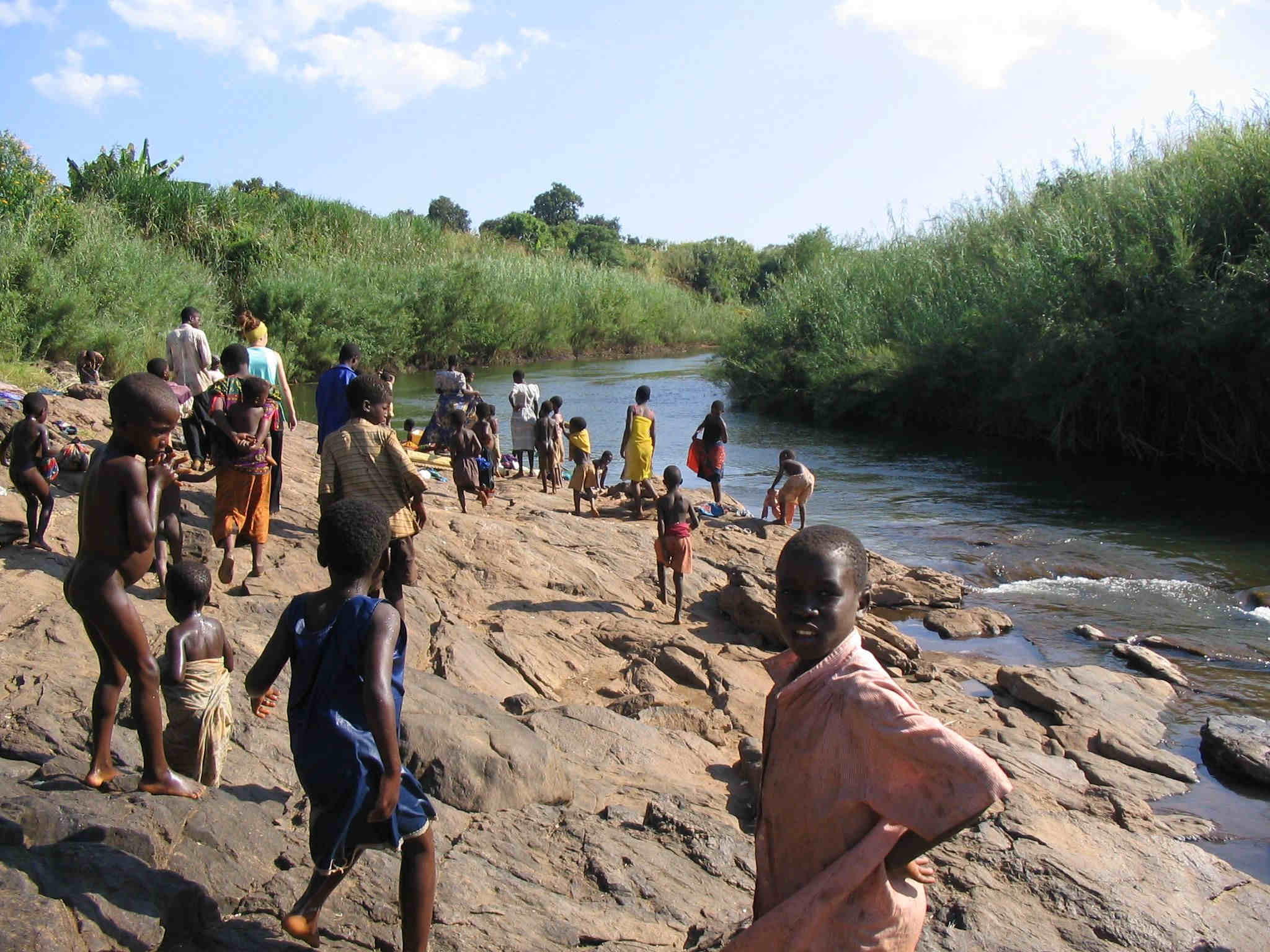Malawi 2004 - 2007 |
||
Chewa Culture and Mua
|
||
Mua is a small village cuddling up to the range of mountainous hills between it and Dedza . It has a rough road leading from the Balaka road to a small bridge over a river that runs to a pool by rocks that are known as 'The washing pots' by local people. Watching the women crouched on the rocks washing clothes and pans links you into an unbroken thread leading to the source of the river of human existence. Stand at this spot at any time in the last thousand years and you would have seen the same scene. Mua is also the home of a Catholic Mission that has been home to Father Boucher- Chisale WF, a French-Canadian man in late middle age who was a young man when he came here. He is sitting in a small flower-fringed bower with a Malawian companion, deeply concentrated on the abstract pattern they are painting on a table-cloth sized canvas. They talk easily and quietly in Chichewa, and if you ask him a question he answers calmly and patiently without raising his gaze or disturbing his intricate task. He is spreading around the waist and his full moon face is dignified by a tidy grey beard and short tousled hair. He wears old shorts and a loose African smock. He has the air of a man who is comfortable in his shoes. He is king in this kingdom and has no need to display his power. Raise your eyes and you will see a small shop with a range of wooden carved objects spilling out of the door onto the patio in front. Behind you is a hedge with an old iron gate that leads to the centre piece of this man's creation - the cultural museum. He has managed over thirty years to marry his two worlds, The Catholic church and the African tradition of ritual, and magical symbolism. When he arrived the Christian world was at war with African culture. Primitive beliefs and heathen worship were to be replaced by civilised, incense shrouded ritual, original sin and worship of a tortured figure on a wooden cross. His good fortune was that the Catholic church changed its view of African religion. Take-over became merger, regime change mutated into alliance. The policy was known as inculturalisation . Father Boucher was a natural leader of this new fashion. He became interested in the Gulewamkulu tradition of the Chewas and the beliefs and rituals of the Ngonis and Lomwe tribes who also settled in the area. He came to respect the long and rich heritage of tribal culture and came to see it as a valuable tradition to be cherished and protected. Come to church on Sunday and enjoy your culture for the rest of the week. Such was his commitment that he went through the Gulewamkulu and Ngoni initiation himself. The KuNgoni Art Centre is the tangible progeny of his passion in this small but otherwise unremarkable small community. The cultural museum is a site of large, linked round buildings, decorated with Ngoni and Chewa murals, housing imaginative collections of photos, artefacts and written commentary. An artist himself, Father Boucher has painted his passion onto the Mission banner, a large theological art work . He has also developed the local craft industry that produces the carved screens, bowls, and figures that are sold to tourists. Step inside the museum for a moment and you will see a large circular room with a high roof. To your left are black and white photos of the early missionaries - there is David Livingstone, here are the white fathers, look at the village, the houses are much closer together and the scene is much more crowded - was this protection against greater danger? Large paintings display the African-Christian link. The next chamber houses the Chewa culture. The walls are covered with photos of Chewa ceremonies. In the centre a large tree sculpture is festooned with masks, abstract animal figures and artefacts. The objects are colourful and often grotesque. Black, red and white feature strongly and animal figures are often long-grass fringed and shapeless.
When I started to read the commentary to the masks I went through a mirror into a world I had no idea existed. These slightly comical and naïve works of art were, in fact, a visual bible, a dramatised life of the ancestors and a guide to life. Number 2 Maria, is a key ceremonial figure. She is a pink faced response to the early Christian missionaries and mocks the Christian Mother Mary. Number 201 is a black faced angry mask with close spaced eyes. It is an unpredictable violently angry man who abuses his parents and beats his wife. In ritual, women are warned to avoid this man. Hyenas are cowardly liars. There is even a white-faced white head with a bald pate and tufts of ginger hair above the ears. He is the agricultural advisor. A more modern creation and figure of fun. A figure that makes farmers change their traditional ways. All of life is here in the Gulewamkulu tradition and acted out at weddings , funerals, and coronations.
The young men who are initiated into the tradition take on the roles of the ancestors and like priests, become the earthly embodiment of powerful spirits by cloaking their bodies in ritual robes. Recently a Gulewamkulu came through a village being visited by our girls to contact young women. The girls rushed into a hut and shut the doors. " Why are you hiding?" "It is a Gulewamkulu ." "What will he do?" "He will take you away." "Has that ever happened to anyone you know?" "No."
In Chewa culture sex is a powerful mediator and differentiates human states between hot and cool. Chiefs must abstain from sex in times when the state must be cool. Entry into other states of life transforms the environment to hot. Ritual embodies these states and protects individuals against harmful spirits. In a world of high mortality fertility is important in the culture. It is a gift to the community not the individual. Chauta , is the female god figure associated with a bow that stretches the rainbow across the sky bringing rain and fertility. She channels fertility through the ancestors to the community. The complex sexual rules are designed to create the correct conditions for fertility. Hot and cold should not be mixed. A cool pot in a hot fire will crack and break. Thus , sex is taboo in initiation, beer brewing, iron smelting, potting and hunting. Hot people can ruin any of these activities or affect the vulnerable. Babies may suffer ndulo (cutting) a shaking disease if close to a hot person before ritual entry to the world. Although churches have linked many of the cultural practices to witchcraft Father Boucher says they have brainwashed people. It is difficult for the outsider to peep behind the mask of public orthodoxy, but the 'big dance' ( gulewamkulu ) is still very much alive, even if the dancers wear Manchester United and Chelsea football scarves and witchcraft is still a feared and powerful influence in the lives of village and educated people.
***************************
|
||



